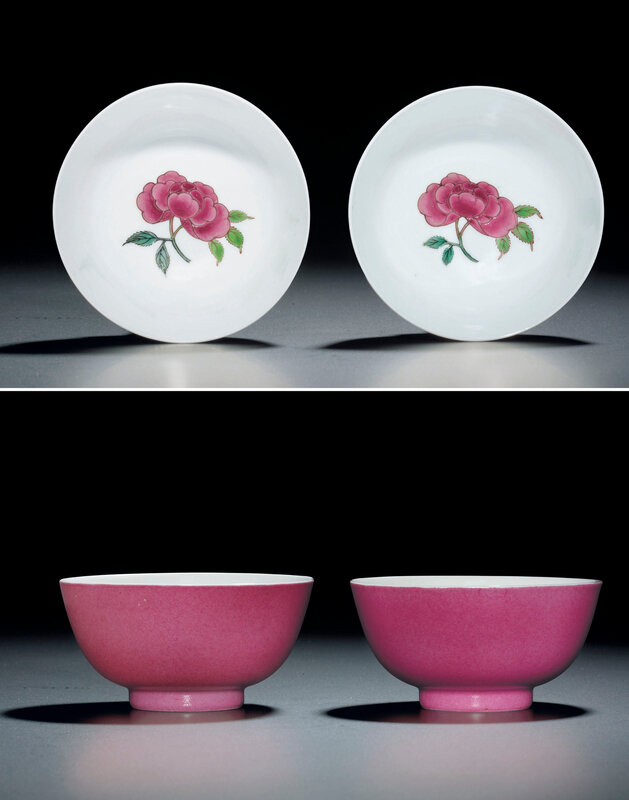Each bowl is finely potted with steep rounded sides rising from a straight foot. The interior of each is finely enamelled with a single large peony spray. The exterior is covered with orange peel textured pale pink enamel stopping neatly at the foot. The base is covered in a transparent glaze, box (2).
Provenance: H.M. Knight Collection
Sold at Sotheby's London, The Property of H.M Knight Esq., 12 May 1970, lot 114
E.T. Hall Collection, nos. 377 and 378
Sold at Christie's London, Chinese Monochrome Porcelain from the Collection of Professor E.T. Hall, C.B.E., 7 June 2004, lot 140.
Note: One of the achievements of the potters at the Imperial kilns, after their restoration in the early years of the Kangxi reign, was the increase of alkali level into the glaze recipe so that it produced a dense, slightly more opaque, glaze against which enamel colours would appear brighter. For a discussion, see R.E. Scott, '18th Century Overglaze Enamels: the Influence of Technological Developments on Painting Style', Style in the East Asian Tradition, (R.E. Scott ed.), Colloquies on Art and Archaeology in Asia No. 14, London, 1987, pp. 152-3.
Most scholars believe that pink enamel seems first to have appeared in the Chinese palette at the end of the Kangxi reign, in about AD 1720. Microscopic examination of this pink enamel has shown red particles immersed in a clear lead-potassium-silicate glass. The rose colour was due to minute colloidal particles of gold. The Chinese rose enamel appears different from the European equivalent colour - the so-called 'Purple of Cassius', developed by Andreas Cassius of Leyden in about 1670. It does not appear to have been made by the European 'Purple of Cassius' method. The Chinese enamel has a much lower tin content and the scientists concluded that it was made not by precipitation but by making up a ruby glass and grinding this up as a pigment to be dispersed in the clear enamel. The advantage of the Chinese method, was that it used less gold, and it was also easier to achieve an even colouration within the enamel.
A number of similar examples of Yongzheng period pink enamelled cups and bowls in the National Palace Museum are listed and discussed in the exhibition catalogue of Porcelain with painted enamels of Qing Yongzheng period, Taipei, 2013, pp. 308-313, where it is mentioned that under microscopic examination, the majority of these pieces show the presence of gold micro particles.
Christie's. IMPERIAL SALE: IMPORTANT CHINESE CERAMICS AND WORKS OF ART. 29 May 2013. Convention Hall.

/https%3A%2F%2Fprofilepics.canalblog.com%2Fprofilepics%2F1%2F0%2F100183.jpg)
/https%3A%2F%2Fstorage.canalblog.com%2F03%2F02%2F119589%2F96711876_o.jpg)
/https%3A%2F%2Fstorage.canalblog.com%2F11%2F31%2F119589%2F94773502_o.jpg)
/https%3A%2F%2Fstorage.canalblog.com%2F20%2F83%2F119589%2F94772815_o.jpg)
/https%3A%2F%2Fstorage.canalblog.com%2F26%2F72%2F119589%2F75604929_o.jpg)
/https%3A%2F%2Fstorage.canalblog.com%2F59%2F60%2F119589%2F26458628_o.jpg)



/http%3A%2F%2Fstorage.canalblog.com%2F57%2F78%2F119589%2F129759940_o.jpg)
/http%3A%2F%2Fstorage.canalblog.com%2F76%2F00%2F119589%2F129065442_o.jpg)
/http%3A%2F%2Fstorage.canalblog.com%2F99%2F10%2F119589%2F129064621_o.jpg)
/http%3A%2F%2Fstorage.canalblog.com%2F18%2F84%2F119589%2F129061143_o.jpg)